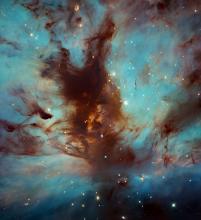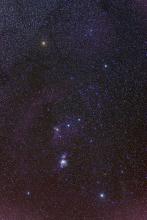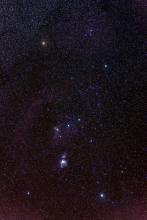Listen to today's episode of StarDate on the web the same day it airs in high-quality streaming audio without any extra ads or announcements. Choose a $8 one-month pass, or listen every day for a year for just $30.
You are here
Good Night, Orion
One of the most beautiful of all constellations is putting in its final evening appearance of the season over the next few nights. It soon will disappear in the Sun’s glare. The next time we see it, it’ll be in the morning sky shortly before sunrise.
Orion, the hunter, is low in the west as early twilight begins to fade. Its most prominent feature is a short line of three stars called Orion’s Belt. The belt aligns almost parallel to the horizon, and sets a couple of hours after the Sun.
Below and to the left of the Belt, look for Rigel, the constellation’s brightest star. It normally shows a brilliant blue-white color. It’s so low in the sky now, though, that the color will be washed out.
Rigel is a supergiant star. That means it’ll live a brief but spectacular life, then die an even more spectacular death — in a titanic explosion called a supernova.
Orion’s most famous star is Betelgeuse, which stands above and to the right of the belt. It, too, is a supergiant, but it’s red, not blue. That indicates that Betelgeuse may be farther along in its evolutionary path than Rigel is, and closer to that big end-of-life explosion.
Look for these two future exploding stars quite low in the western sky in early evening the next few nights. Rigel will disappear in the evening twilight within a week or so, depending on your latitude, with Orion’s Belt following a few days later, and Betelgeuse toward the middle of May.
Script by Damond Benningfield





